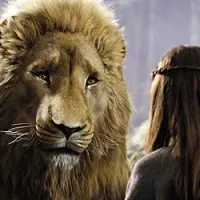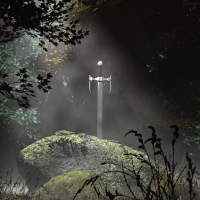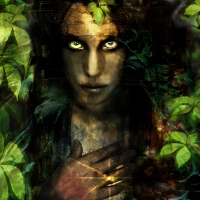Fifty years after its first publication, The Lord of the Rings found a new and even larger audience in a new medium, the three films directed by Peter Jackson and released in successive years 2001–2003. These are some of the most successful films ever made. The three between them had taken some £1,279 million at the box office, a figure certainly multiplied by VOD and DVD sales, especially of the extended versions which will give a final total running time of close on twelve hours. It is impossible to estimate how many viewers this will represent, since one DVD can be seen by many people, and conversely the box office takings are inflated by repeat viewers, but it is safe to say that hundreds of millions of people have seen or will see the films. There will almost certainly be more viewers than readers (though of course they are often the same people). In light of this it may seem bizarre that while Peter Jackson was making the films, the moguls of Hollywood, alarmed at the ever-increasing scale and cost of the production, sent to New Zealand a ‘script doctor’, whose job it was to get the films back on track. The ‘script doctor’ immediately saw the faults in the Tolkien plot. Having heroes riding (or in this case walking) to the rescue of a threatened people was of course perfectly familiar and acceptable, as in The Magnificent Seven: but there was no need to have two threatened peoples, Rohan and Gondor. One of them could be cut out, which meant that the battle of Helm’s Deep could be amalgamated with the battle of the Pelennor Fields. A love-interest for Aragorn was also clearly vital, but once again there was no need for two of them: either Arwen or Éowyn should go, preferably Arwen, and Aragorn should then marry Éowyn instead of politely dissuading her. One could then make a further saving by eliminating the figure of Faramir. Meanwhile, though there was some doubt about the wisdom of having such small and unheroic figures as hobbits as heroes, they might be retained as a gimmick: but four of them were one too many. And it was absolutely vital that one of the hobbits should die. With changes like these, The Lord of the Rings could be converted into a perfectly acceptable, run-of-the-mill movie script–at the expense, of course, of cultural contrast, originality, emotional depth, and a few other inessentials. The script doctor’s advice was ignored, and Jackson’s films perhaps convinced even the moguls in the end that there was something they did not know about popular appeal. Nevertheless, the changes proposed do say something about the individual and even eccentric nature of Tolkien’s work. So often it does not do what one might expect. But the success of the films does raise a more important issue. For many people, The Lord of the Rings now means the film version, not the books. In what ways are the two versions different, and would Tolkien himself have approved of the difference?
The Seventh Circle of Hell
10 Nov
Something a little different but perhaps appropriate for the season, coming on the heels of Hallowe’en and at the beginning of November, known to Anglo-Saxons as Blotmonath or ‘the month of blood’ – a post about Hell! In religion and folklore, Hell is an afterlife location in which evil souls are subjected to punitive suffering, often torture as eternal punishment after death. The modern English word hell is derived from Old English hel, helle (first attested around 725 AD to refer to a nether world of the dead) reaching into the Anglo-Saxon pagan period. Hell appears in several mythologies and religions. It is commonly inhabited by demons and the souls of dead people. A fable about Hell which recurs in folklore across several cultures is the allegory of the long spoons. Hell is often depicted in art and literature, perhaps most famously in Dante’s Divine Comedy. Other religions, which do not conceive of the afterlife as a place of punishment or reward, merely describe an abode of the dead, the grave, a neutral place that is located under the surface of Earth (for example, see Kur, Hades, and Sheol). Such places are sometimes equated with the English word ‘hell’, though a more correct translation would be ‘underworld’ or ‘world of the dead’. From illustrations in The Far Side comics and TV’s South Park, to centuries-old works like Paradise Lost and Dante’s Inferno, humanity has always wanted answers about hell. Lots of people have theories, some based in fact and some based on fiction.
The 10 percent of the brain myth
13 Oct
Lucy is a 2014 English-language French science fiction action film written and directed by Luc Besson, which stars Scarlett Johansson. Johansson portrays the titular character, a woman who gains psychokinetic abilities when a nootropic drug is absorbed into her bloodstream. At the time the film received positive, but also polarizing, critical reviews. Although praise was given for its themes, visuals, and Johansson’s performance, a number of critics found the plot nonsensical, especially its focus on the ‘ten percent of the brain myth’ and resulting abilities. This is a widely perpetuated urban legend that most or all humans only use 10 percent (or some other small percentage) of their brains. It has been misattributed to many people, including Albert Einstein. By extrapolation, it is suggested that a person may harness this unused potential and increase intelligence. However, the popular notion that large parts of the brain remain unused, and could subsequently be “activated”, rests in folklore and not science. Though specific mechanisms regarding brain function remain to be fully described e.g. memory, consciousness etc. the physiology of brain mapping suggests that all areas of the brain have a function.
Grimm Fairy Tales
8 Sep
Fairy tales—at least as we know them—are a childhood staple. We know the classics by heart, but our beloved Disney-diluted iterations couldn’t be further from their true, markedly more sinister origins. While Walt Disney brought us some of our most beloved children’s stories, the original Brothers Grimm fairy tales are definitely not for kids. The Grimm brothers, a pair of German siblings who created some of the original tales in the 19th century, didn’t shy away from any gory details and left an astounding legacy. Born in the city of Kassel in the 18th century, Jakob and Wilhelm Grimm documented hundreds of folktales from all over Europe. They were linguists, scholars, and researchers of German language and mythology, yet they lived most of their lives as underpaid academics – and likely never realized their work would someday reach world fame. Despite the fact that Jacob and Wilhelm Grimm are often associated with Snow White and Rapunzel, the brothers didn’t actually write any of those stories. In fact, the stories existed long before the two men were born in Germany in the mid 1780s. The fairy tales, in fact, were part of a rich oral tradition − passed down from generation to generation, often by women seeking to pass the time during household chores. But as industrialization took root, local traditions changed and scholars, like Jacob and Wilhelm, began a quest to save the stories from extinction. They interviewed relatives and friends, collecting whatever tales they could, sometimes embellishing them (although they insisted they did not). In 1812, Jacob and Wilhelm published the stories as part of a collection titled Nursery and Household Tales, or what is now referred to as Grimm’s Fairy Tales.
Saga
11 Aug
Saga is an epic space opera/fantasy comic book series written by Brian K. Vaughan and illustrated by Fiona Staples, published monthly by Image Comics. A tree that doubles as a rocket ship. Aristocratic villains in 18th-century military dress with televisions for heads. A hairless cat who growls “LYING” at any knowingly untrue statement. A planet-sized bordello hosted by a pair of women’s heads on fishnet-stocking-wearing legs. This is but a dash of the unbelievable imagery you encounter in just the first six issues of Saga – a comic-book epic proves there’s still room for originality in the over-franchised world of sci-fi. The space opera—a sub-genre of science fiction that tends towards vivid, romantic fantasy and swashbuckling action and away from “harder,” more speculative sci-fi—has never really gone fully out of vogue since the success of Star Wars. But it’s gotten pretty stagnant, recycling the most universally recognizable tropes. What Saga is doing feels different and invigorating. It’s inspired by a fictional universe Vaughan created as a child and never stopped revisiting, and its core elements have the kind of loopy, fearless freshness only a young mind could generate.
Kimba the White Lion
7 Jul
With the pending release of the ‘live-action’ remake of Disney’s animated classic The Lion King, now is perhaps the perfect time to look at one of the strangest controversies ever to follow a Disney cartoon. At the time of its release, The Lion King was a unique production from Disney. It was the first animated film from the studio to feature an original story created by its team of writers. Over the years, however, this claim has faced several credible challenges from the Japanese anime, Kimba, The White Lion, made in 1965. That cartoon, about African wildlife, was based on a Manga comic called Jungle Emperor Leo by animator Osamu Tezuka. Whether Disney was inspired by Kimba isn’t the problem here; rather, it’s that Disney has long asserted that The Lion King was its first original animated film, and that it’s never heard of Jungle Emperor Leo or Tezuka. When you see the side-by-side glimpses afforded by YouTube it’s pretty impossible not to see the similarities, whether it be in the characters themselves, the design flourishes, or even specific shots. Yes, Kimba’s dad dies by drowning rather than wildebeest stampede, but his clamber up the rock wall and denial of saving by the story’s nefarious antagonist still looks familiar. Obviously, this isn’t a cry to disavow The Lion King or any such thing; it’s still a great film. But this may be one controversy that merits a closer look – after all, it was even once parodied, famously, in an episode of The Simpsons (you remember: the one where Mufasa appears in the clouds, bidding Lisa to “avenge my death, Kimba—I mean, Simba”)!
Fantasy Masterworks: Little, Big
16 Jun
Little, Big: or, The Fairies’ Parliamentis a modern fantasy novel by John Crowley, published in 1981, which won the World Fantasy Award in 1982. An extraordinary, sweeping and strange novel, it can perhaps be best described through the metaphor of its central setting: Edgewood, the house in which many generations (and permutations) of the Drinkwater family live. Edgewood is designed by the patriarch, a renowned architect, to be many houses within a single structure. It unfolds, as the viewer circles around it, to reveal many different facades — Victorian, modern, gothic — like a complex piece of origami. Little, Big is one of those sprawling, dream-like fantasy novels, much like Mark Helprin’s fantastical history of a mythical early 20th-century New York, Winter’s Tale. Like another counterpart, One Hundred Years of Solitude, but this time set in New England, Little, Big spans several generations of the Drinkwater family and their relationship with the world of faerie. The concept is rescued from tweeness by author Crowley’s dazzling feats of aerobatics with the English language, which at first take a bit of getting used to but, ultimately, draw you in and trap you with their beauty, not unlike the fabled world of faery itself. The esteemed literary critic Harold Bloom called Little, Big “a neglected masterpiece. The closest achievement we have to the Alice stories of Lewis Carroll”, and the vast novel does have an almost soporific, Wonderland quality to it – best read on lazy days in dappled sunshine.
American Mythic
19 May
When we think of mythology we tend to think of the old world – European fairytales, folklore of the Far East and tales from the dark continent of Africa. Even when the new world is mentioned, in mythic terms it is the Native American folklore of the tribes and nations that first settled the lands of North and South America that comes to mind. Whilst all of this world mythology represents a rich and varied tradition of fairytales, folklore and legends, this is also to ignore the unusual and fascinating modern mythology of the United States. There are lots of interesting directions that this ‘American Mythic’ takes. There are larger than life stories of the birth of the nation, its founding fathers and the Revolutionary War; there is an entire mythology surrounding the Civil War that almost ripped apart the nascent union, when brother fought brother and fire and blood threatened to consume all the land from sea to shining sea; and up to the present day the Cold War and many other conflicts that have shaped the postwar nation also contributed to the character and myths of the modern United States. Anyone who takes the time and trouble to investigate American Mythic might be surprised at what they find.
The Music of John Williams
14 Apr
With a career spanning over six decades, John Williams has composed some of the most popular, recognizable, and critically acclaimed film scores in cinematic history, including those of the Star Wars series, Jaws, Close Encounters of the Third Kind, Superman, E.T. the Extra-Terrestrial, the Indiana Jones series, the first two Home Alone films, Hook, the first two Jurassic Park films, Schindler’s List, and the first three Harry Potter films. Williams has won 24 Grammy Awards, seven British Academy Film Awards, five Academy Awards, and four Golden Globe Awards (with 51 Academy Award nominations, Williams is the second most-nominated individual, after Walt Disney). Williams also composed the score for eight of the top 20 highest-grossing films at the U.S. box office (adjusted for inflation). Despite this awesome CV, or perhaps as a contributory factor, Williams has a style and approach almost unlike any other film composer. While skilled in a variety of 20th-century compositional idioms, Williams’s most familiar style may be described as a form of neoromanticism inspired by the late 19th century’s large-scale orchestral music—in the style of Tchaikovsky or Richard Wagner’s compositions and their concept of leitmotif—that inspired his film music predecessors. Williams is associated with a who’s who of history’s greatest film-makers, including Steven Spielberg, for whom Williams composed music for all but three of his feature films. However it is another cinematic legend – George Lucas – for whom he reserved perhaps his greatest achievements in the form of the soundtrack to Star Wars, which was preserved by the Library of Congress into the National Recording Registry for being “culturally, historically, or aesthetically significant”.
Monstress
17 Mar
Monstress, by Marjorie Liu, uses a unique fantasy setting to tell the epic story of a magically inspired war. In it, readers are instantly thrust into a world of strange creatures, unique magic, and an unexplained conspiracy which gets more and more interesting with every page. Liu does a fantastic job in crafting a world with a lore so dense that it feels like we have only just scratched the surface of everything there is to learn. This is a compelling series pushed forward by strong, yet beautifully flawed characters making their way through this world and uncovering aspects of it which we are only just beginning to understand. The end result is a graphic novel that doesn’t just appeal to fantasy lovers, it also appeals to anyone interesting in epic stories set in detailed and elaborate worlds. Before even getting into the actual story behind this series, the sheer scope of the worldbuilding present here must be addressed. Liu has created a society with a rich history of war and development, that has a number of strict rules for the storyline to follow. There are multiple distinct races; magical elements, whose properties remain surprisingly consistent; and a full history behind every character, location, and artifact. Discovering all of this becomes one of the reader’s biggest objectives and gives them something to look forward to with every page they read.
















